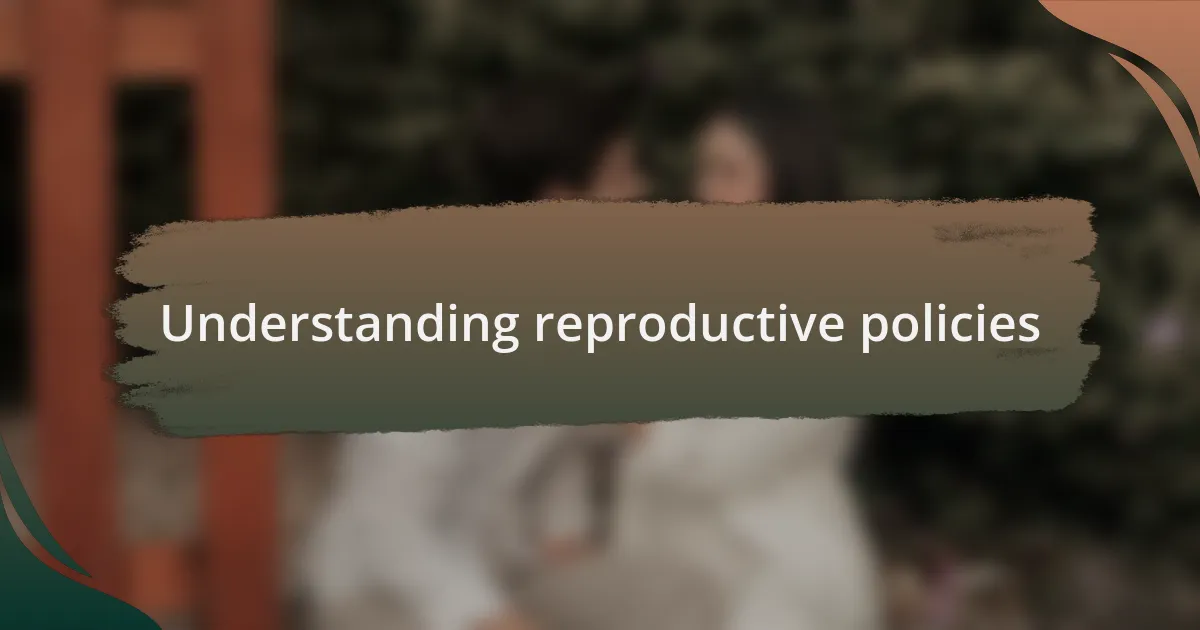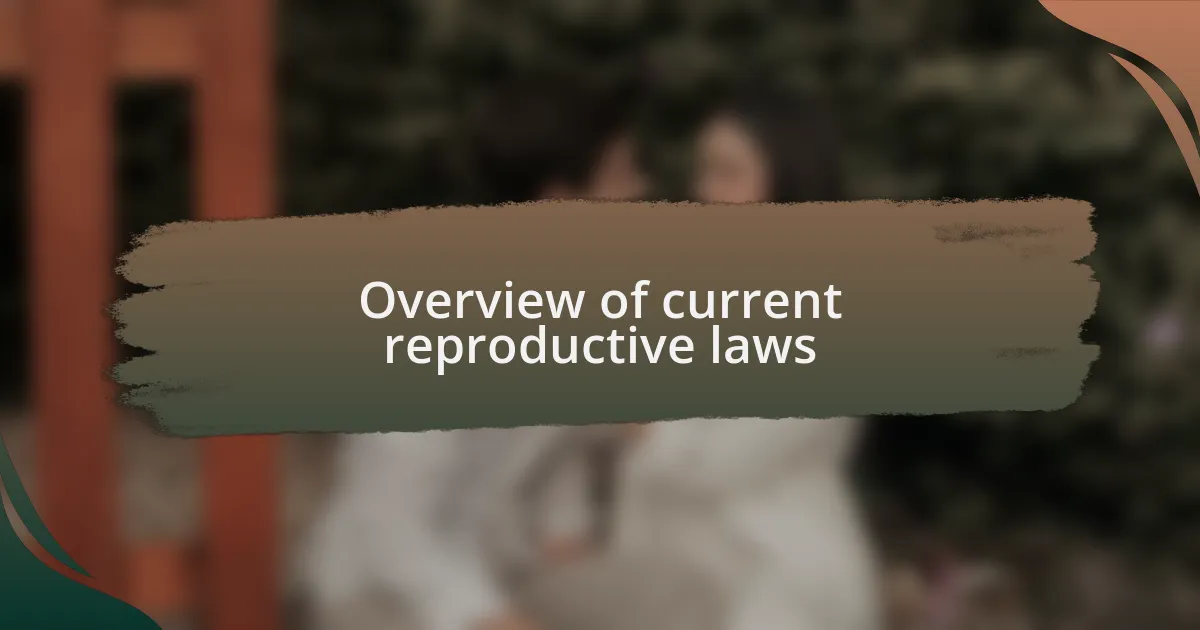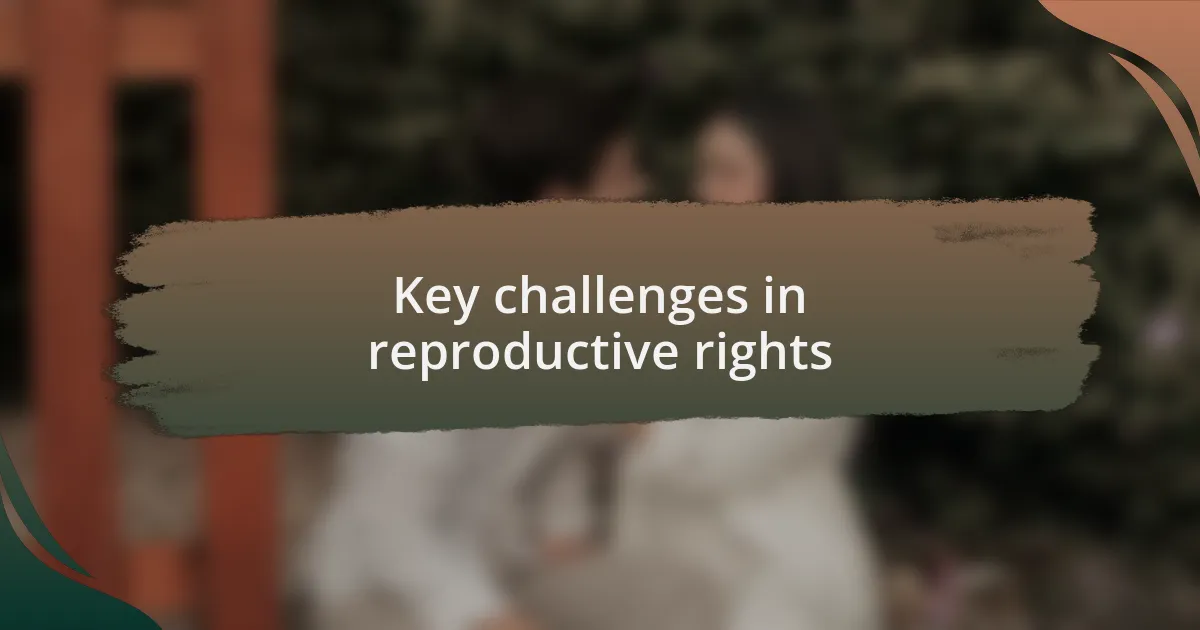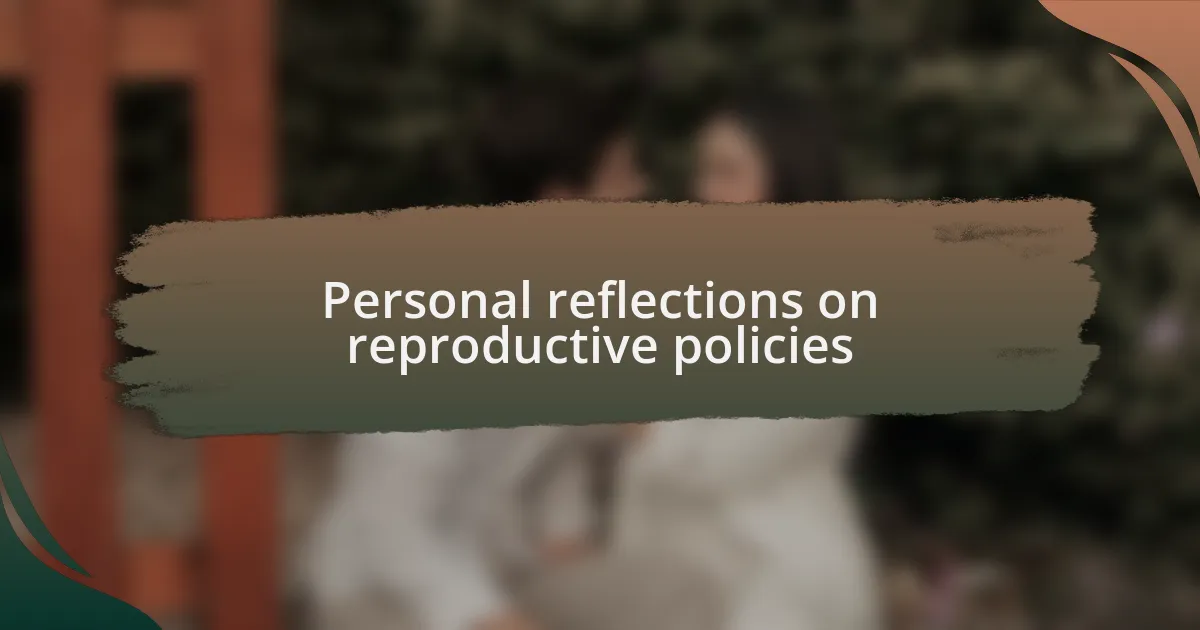Key takeaways:
- Reproductive policies significantly impact women’s lives, reflecting societal values and often creating legal barriers to health choices.
- Access to women’s health resources is essential for individual well-being and societal progress, particularly in underserved communities.
- Key challenges in reproductive rights include legal restrictions, stigma, and misinformation that hinder women’s autonomy and access to care.
- Advocacy through storytelling, grassroots mobilization, and digital platforms can effectively raise awareness and push for change in reproductive rights.

Understanding reproductive policies
Reproductive policies are often deeply intertwined with various moral, ethical, and health considerations. I remember a conversation I had with a friend who faced tough choices due to restrictive laws surrounding contraception in her state. It made me realize how vital it is to understand these policies—not just as abstract concepts, but as real barriers or supports that can shape a woman’s life trajectory.
When I think about the evolution of reproductive policies, I’m struck by how they reflect societal values and priorities. Have you ever felt frustrated by how long it takes for laws to adapt to the needs of women today? It’s fascinating—and infuriating—to examine how changes in leadership can drastically shift the landscape, often leaving women in limbo as they navigate their rights.
The complexity of reproductive policies can sometimes feel daunting, with layers of regulations that vary by region. I recall a time when I was helping a family friend understand her options regarding pregnancy termination; the labyrinth of laws nearly disoriented us. This experience underscored how crucial it is for women to be well-informed about their rights, enabling them to advocate effectively for their health choices.
The importance of women’s health
Women’s health is fundamental not only for individual well-being but also for societal progress. I vividly recall attending a health seminar where women shared their struggles with accessing necessary healthcare services. Hearing their stories was a powerful reminder that when women’s health is prioritized, entire communities benefit through enhanced productivity and economic stability.
It often amazes me how poorly informed women can be about their own health rights. Just the other day, I spoke with a colleague who was surprised to learn about the range of preventive services covered by health insurance. It made me wonder—how can we expect women to make informed choices if they aren’t even fully aware of their options?
I’ve seen first-hand how the availability of health resources impacts women’s lives, particularly in underserved communities. I volunteered at a local clinic, and the gratitude expressed by women who received preventive care was palpable. This experience reinforced my belief that equitable access to women’s health resources isn’t just a healthcare issue; it’s a crucial aspect of social justice.

Overview of current reproductive laws
Reproductive laws are complex and often vary significantly across regions. For instance, in some areas, stringent regulations exist that limit access to contraceptive methods, while others emphasize reproductive rights more broadly. I remember a conversation with a friend who had just moved to a state with restrictive laws; she was shocked to find out that her access to basic reproductive health services was suddenly jeopardized.
In my experience, the inconsistency in reproductive policies can be jarring. I once attended a workshop where women from different states shared their experiences navigating these laws. It was eye-opening to see how one’s zip code could determine access to essential services, leaving me to ponder—how can we build a society where rights aren’t dictated by geography?
Additionally, the ongoing debates around reproductive laws often reflect deeper cultural attitudes towards women’s autonomy. I recall attending a rally where passionate advocates spoke about the need for comprehensive reproductive rights. Listening to their personal stories made it clear that these laws are not just policies; they directly impact lives, hopes, and futures. Are we really prepared to disregard the individual journeys that shape our understanding of health and freedom?

Key challenges in reproductive rights
Key challenges in reproductive rights often stem from a mix of legal barriers and societal attitudes. I remember speaking with a healthcare provider who was frustrated by the limitations placed on her ability to offer comprehensive reproductive advice. She shared that even when she believes in a patient’s right to choose, local laws often dictate what she can or cannot discuss, making her feel like she’s working under a heavy weight of restrictions.
Another significant challenge is the stigma surrounding reproductive health. I once joined a community event where the topic of reproductive rights came up, and the room fell silent. Many shared their fears about discussing their needs openly. This stigma not only silences voices but also prevents individuals from seeking the healthcare they deserve. Why should anyone feel ashamed of accessing necessary medical services?
Furthermore, misinformation plays a dangerous role in shaping public opinion. I’ve had conversations with individuals who hold misconceptions about what reproductive health services entail. It’s disheartening to see how these misunderstandings create fear and opposition to policies meant to protect rights. How can we expect to make progress if we’re wrestling with outdated and inaccurate beliefs?

Personal reflections on reproductive policies
Personal reflections on reproductive policies often lead me to consider the real-life implications behind the laws. I remember a time when a friend shared how she felt anxious about seeking advice on contraception due to fear of judgment. It made me realize how crucial it is for policies to not only exist but to reflect the needs of the people they aim to serve. What does it say about our society if individuals feel they can’t seek help?
When I think about the complexities of reproductive policies, I often return to conversations I’ve had with diverse groups. During a workshop, a participant opened up about how restrictive laws in their state hindered their healthcare choices. Their frustration resonated with me deeply; it’s hard to fathom that people are denied autonomy over their own bodies due to outdated regulations. What kind of message are we sending to future generations about their rights?
Reflecting on my own experiences with advocacy, I can’t help but feel a mix of optimism and frustration. I once organized a rally that unexpectedly drew in a crowd passionate about change. As we exchanged stories, it became clear that personal narratives are powerful tools for progress. Isn’t it fascinating how sharing one’s truth can ignite collective action? The journey ahead may be challenging, but every voice matters in crafting a future that respects and upholds reproductive rights.
Advocacy strategies for women’s health
Advocacy strategies for women’s health must be as diverse as the needs of the women they aim to support. I recall a local event where health advocates used storytelling to convey the struggles faced by women in accessing reproductive care. This experience underscored the power of narrative; when we share personal stories, we humanize the complexities of these issues and inspire empathy in our audience. How can we expect change without first making people feel the urgency of our cause?
One effective approach I’ve seen is grassroots mobilization. While volunteering for a women’s health organization, I helped organize community forums that allowed women to voice their concerns directly to policymakers. The energy in the room was palpable as women shared their experiences and demanded better options for healthcare. Witnessing that kind of engagement drives home the point that when women rally together, their collective voice can create undeniable pressure for change. What tangible outcomes could arise from further amplifying these grassroots efforts?
Incorporating digital platforms into our strategies can also amplify our reach and create ongoing dialogues. I remember launching a social media campaign focused on access to reproductive health services in underserved areas. The response was remarkable—women began sharing their stories online and connecting with each other, fostering a sense of community that transcended geographical boundaries. Isn’t it incredible how technology can bridge gaps and create a united front for advocacy? Harnessing these tools effectively can elevate our message and galvanize support from allies far and wide.

Looking forward in reproductive rights
As we look forward in reproductive rights, it’s crucial to recognize the shifting landscape of public opinion and policy. I recall a conversation with a close friend who, after navigating her own experiences with reproductive health, became an outspoken advocate. Her realization that change is possible—and necessary—truly inspired me. How often do we overlook the power individuals possess to initiate conversations that can shift societal norms?
The ongoing battles won and lost in reproductive rights remind us that vigilance is essential. I once attended a rally where a young woman shared her story of overcoming significant legal barriers to access the care she needed. The conviction in her voice resonated deeply with me and illustrated that our fight is ongoing. How can we build on such momentum to ensure that every woman can freely access the reproductive health services she deserves?
Moreover, I find hope in the increasing collaboration between various advocacy groups. During a recent summit I participated in, leaders from different organizations came together to share strategies and strengthen their networks. It made me wonder: what if we could unite our voices even further and create an unstoppable wave of support for reproductive rights? This cooperative spirit has the potential to reshape policies for the better, making reproductive health a cornerstone of women’s rights advocacy.